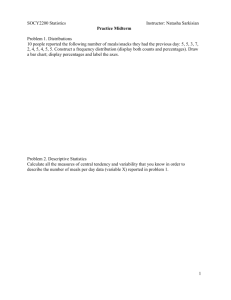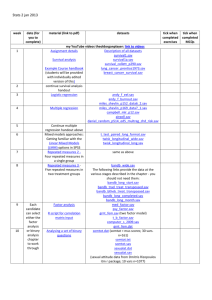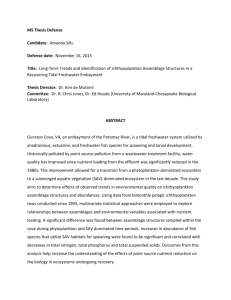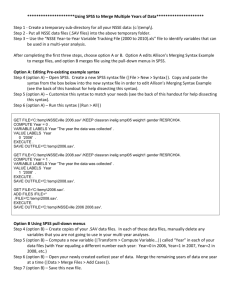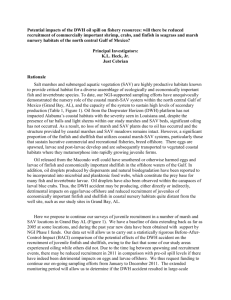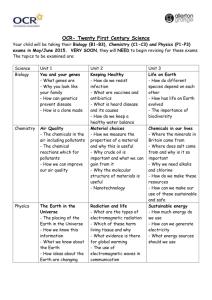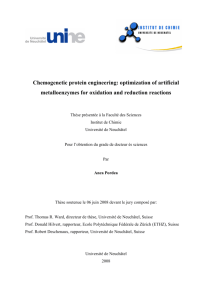karnofsky performance status scale definitions rating (%) criteria
advertisement
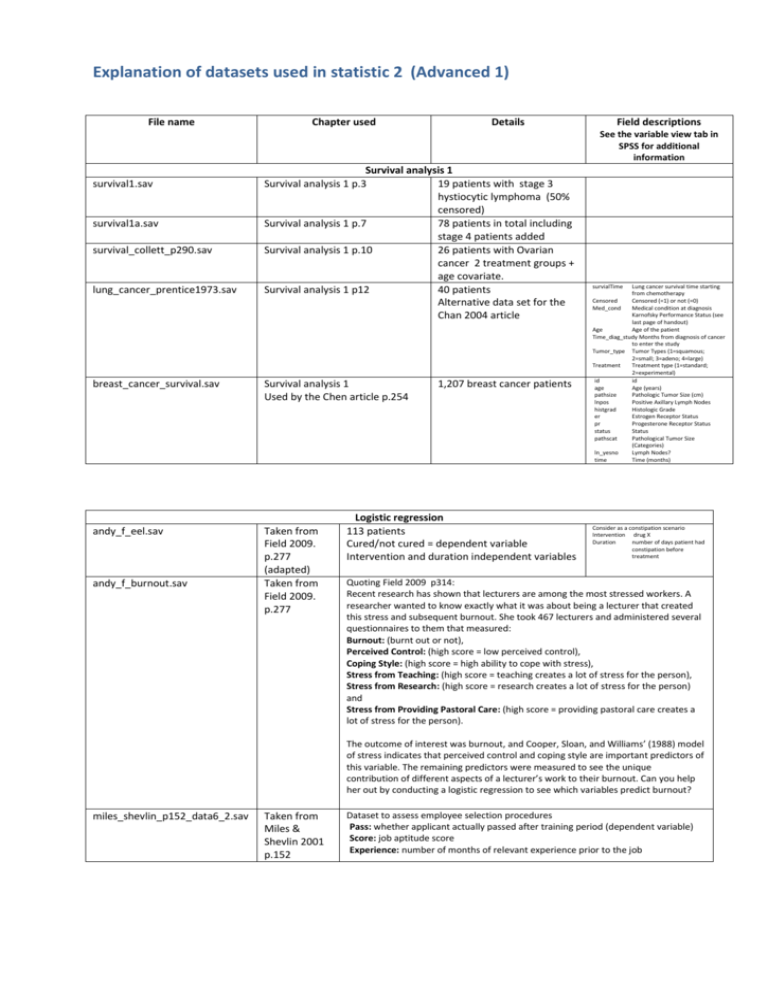
Explanation of datasets used in statistic 2 (Advanced 1) File name Chapter used Details Field descriptions See the variable view tab in SPSS for additional information survival1.sav survival1a.sav survival_collett_p290.sav lung_cancer_prentice1973.sav Survival analysis 1 Survival analysis 1 p.3 19 patients with stage 3 hystiocytic lymphoma (50% censored) Survival analysis 1 p.7 78 patients in total including stage 4 patients added Survival analysis 1 p.10 26 patients with Ovarian cancer 2 treatment groups + age covariate. Survival analysis 1 p12 40 patients Alternative data set for the Chan 2004 article breast_cancer_survival.sav Survival analysis 1 Used by the Chen article p.254 andy_f_eel.sav Taken from Field 2009. p.277 (adapted) Taken from Field 2009. p.277 andy_f_burnout.sav 1,207 breast cancer patients Logistic regression 113 patients Cured/not cured = dependent variable Intervention and duration independent variables survialTime Lung cancer survival time starting from chemotherapy Censored (=1) or not (=0) Medical condition at diagnosis Karnofsky Performance Status (see last page of handout) Age Age of the patient Time_diag_study Months from diagnosis of cancer to enter the study Tumor_type Tumor Types (1=squamous; 2=small; 3=adeno; 4=large) Treatment Treatment type (1=standard; 2=experimental) id id age Age (years) pathsize Pathologic Tumor Size (cm) lnpos Positive Axillary Lymph Nodes histgrad Histologic Grade er Estrogen Receptor Status pr Progesterone Receptor Status status Status pathscat Pathological Tumor Size (Categories) ln_yesno Lymph Nodes? time Time (months) Censored Med_cond Consider as a constipation scenario Intervention drug X Duration number of days patient had constipation before treatment Quoting Field 2009 p314: Recent research has shown that lecturers are among the most stressed workers. A researcher wanted to know exactly what it was about being a lecturer that created this stress and subsequent burnout. She took 467 lecturers and administered several questionnaires to them that measured: Burnout: (burnt out or not), Perceived Control: (high score = low perceived control), Coping Style: (high score = high ability to cope with stress), Stress from Teaching: (high score = teaching creates a lot of stress for the person), Stress from Research: (high score = research creates a lot of stress for the person) and Stress from Providing Pastoral Care: (high score = providing pastoral care creates a lot of stress for the person). The outcome of interest was burnout, and Cooper, Sloan, and Williams’ (1988) model of stress indicates that perceived control and coping style are important predictors of this variable. The remaining predictors were measured to see the unique contribution of different aspects of a lecturer’s work to their burnout. Can you help her out by conducting a logistic regression to see which variables predict burnout? miles_shevlin_p152_data6_2.sav Taken from Miles & Shevlin 2001 p.152 Dataset to assess employee selection procedures Pass: whether applicant actually passed after training period (dependent variable) Score: job aptitude score Experience: number of months of relevant experience prior to the job miles_shevlin_p169_data7_1.s av Example of interaction effect between two independent variables. You could convert this exercise into a logistic regression exercise by converting the dependent variable (score) into a dichotomous one, you might want to take the break point as the mean or median score? campbell_mlr_p12.sav airpoll.sav Multiple regression To test the interaction between to the you will need to either create Taken from Miles & Shevlin a interaction term in the dialog boxes or a new variable. 2001 p.169 Data based on a classic study by Godden & Baddeley (1975) examining context dependent memory. Divers were asked to learn material while on the ground (dry) or under water (wet) and also testing on the material in both situations. Score: correct responses to test (dependent variable) Learn: learning condition Test: testing condition Taken from Campbell 2006 p12 Taken from various sources. This is the dataset that most of the material uses in the chapter and described in detail there. Information from 60 U.S. metropolitan areas (McDonald and Schwing, 1973; Henderson and Velleman, 1981) mortalit: total age-adjusted mortality rate, expressed as deaths per 100,000 educatn: median school years completed for those over 25 in 1960 SMSA (Standard Metropolitan Statistical Association) pop_den: population/mile2 in urbanized area in 1960 nonwhite: percentage of urban area population that is nonwhite nox: relative pollution potential of oxides of nitrogen, NOx so2: relative pollution potential of sulphur dioxide, SO2 This is of 1000 patients measuring cardiac health (oxygen consumption) against 4 continuous independent(?) variables: oxygen consumption (dependent variable), systolic BP, total cholesterol, HDL cholesterol and triglycerides.. daniel_random_p514_ed5_ multreg_chd_risk.sav Daniel 1991 t_test_paired_long_format.sav Original twisk_longitudinal_wide.sav twisk_longitudinal_long.sav Repeated measures 2 (4 repeated measures one group) Taken from Twisk 2006 Described in detail in the chapter. 147 subjects Lifestyle and health measures repeated x4 on each Repeated measures 1 bandb_wide.sav Originally discussed in my chapter on assessing a single mean (wide format) This is the long format version 8 subjects before after design. Number of abdominal curls they could manage before and after a training programme. Repeated measures 3 (5 repeated measures 2 treatment groups) Landau & Everitt 2004 p.196) Beck depression Inventory II measurements in two groups receiving two different types of therapy. Each subject measured pre intervention and 4 times thereafter. The following datasets show the data at the various stages described in the chapter - you should not need them: bandb_long_start.sav bandb_trad_treat_transpossed.sav bandb_btheb_treat_transpossed.sav bandb_long_completed.sav bandb_long_month.sav psy_factor.sav Dugard, Todman & Staines H 2010 med_factor.sav Dugard, Todman & Staines H 2010 grnt_fem.sav Various sources, Amos software and Schumacker & Lomax 2004. (two factor model) t_b_factor Tabachnick & Fidell, 2007 p.651 Factor analysis 128 subjects (psychology students) Wechsler Adult Intelligence Scale (WAIS) - real dataset The 11 variables record the subtests: INFORM: information DIGSPAN: digit span VOCAB: vocabulary ARITH: arithmetic COMPREH: comprehension SIMIL: similarities PICCOMP: picture completion PICARRAN: picture arrangement BLOCK: block design OBJASSEM: object assembly DIGSYM: digit symbol Above dataset relabelled to medical context: Here we suppose that a Positive Health Inventory (PHI) is being developed in order to monitor the effectiveness of a free check-up programme. The PHI comprises of 11 subtests, concerning healthy function of the: LUNG: lung function MUSCLE: muscular system LIVER: liver function SKELETON: skeletal function KIDNEYS: Kidney function HEART: Cardiac function STEP: Step test STAMINA: Stamina test STRETCH: Stretch test BLOW: Blowing test URINE: Urine flow test 73 female cases from the Grant-White school, subset of Holzinger & Swineford 1939 dataset. 6 observed variables: visperc: Visual perception cubes: cube identification etc. lozenges: Lozenge identification etc. paragrap: Paragraph comprehension sentence: Sentence completion wordmean: Word meaning Hypothesised that there are two factors (possibly correlated?). Investigate this dataset. Bem Sex Role Inventory (BSRI; Bem, 1974) dataset. This sample consists of 369 middle-class ,English-speaking women between the ages of 21 and 60. The original dataset consisted of 369, but 25 were considered outliers and removed from subsequent analysis. This dataset is the original one. 44 items were recorded for each respondent each representing a different trait (e.g., "gentle," "shy," "dominant") and scored between 1 ("never or almost never true of me") to 7 ("always or almost always true of me") to each of the items. Responses were summed to produce separate masculine (20 items but only 19 recorded), feminine (20 items) and social desirability (5 items) scores. Previous factor analytic work had indicated the presence of between three and five factors underlying the items of the BSRI. Tabachnick & Fidell, 2007 p.652 The conclusion of the analysis was that four factors were identified on the BSRI for this group of women them being: dominance (e.g., leadership abilities and strong personality), empathy (e.g., compassion and understanding), positive affect (e.g., happy and warm), and independence (e.g., selfsufficient and self-reliant). Tabachnick & Fidell, 2007 p.671 The list of items is provided on the following page. Attempt to replicate the main results. 1 2 3 4 5 6 7 8 9 10 11 12 13 14 15 16 17 18 19 20 21 22 23 24 Field name subno helpful reliant defbel yielding cheerful indpt athlet shy assert strpers forceful affect flatter loyal analyt feminine sympathy moody sensitiv undstand compass leaderab soothe 25 26 27 28 29 30 31 32 33 34 35 36 37 38 39 40 41 42 43 44 45 risk decide selfsuff conscien dominant masculin stand happy softspok warm truthful tender gullible leadact childlik individ foullang lovchil compete ambitiou gentle Field label Subject identification self reliant defend beliefs independent athletic assertive strong personality affectionate compassionate leadership ability eager to soothe hurt feelings willing to take risks makes decisions easily self sufficient conscientious willing to take a stand soft spoken act as a leader individualistic use foul language love children competitive ambitious KARNOFSKY PERFORMANCE STATUS SCALE DEFINITIONS RATING (%) CRITERIA Able to carry on normal activity and to work; no special care needed. 100 90 80 Unable to work; able to live at home and care for most personal needs; varying amount of assistance needed. 70 60 50 Unable to care for self; requires equivalent of institutional or hospital care; disease may be progressing rapidly. 40 30 20 10 0 Normal no complaints; no evidence of disease. Able to carry on normal activity; minor signs or symptoms of disease. Normal activity with effort; some signs or symptoms of disease. Cares for self; unable to carry on normal activity or to do active work. Requires occasional assistance, but is able to care for most of his personal needs. Requires considerable assistance and frequent medical care. Disabled; requires special care and assistance. Severely disabled; hospital admission is indicated although death not imminent. Very sick; hospital admission necessary; active supportive treatment necessary. Moribund; fatal processes progressing rapidly. Dead References Campbell 2006 (2nd ed.) Statistics at square 2. BMJ books. Daniel W W 1991 Biostatistics: A foundation for analysis in the health sciences. Wiley. Dugard P, Todman J, Staines H 2010 (2nd ed.) Approaching Multivariate Analysis. Field A 2009 (3rd ed.) Discovering statistics using SPSS. Sage Landau S, Everitt B S 2004 A handbook of statistical analyses using SPSS. Chapman & Hall. Miles J, Shevlin M 2001 Applying regression & correlation: A guide for students and researchers. Sage publications. London Schumacker RE Lomax RG 2004 A beginner's guide to Structural Equation Modelling. Tabachnick BG & Fidell LS, 2007 (5th ed.) Using Multivariate Statistics.

